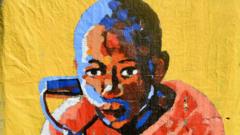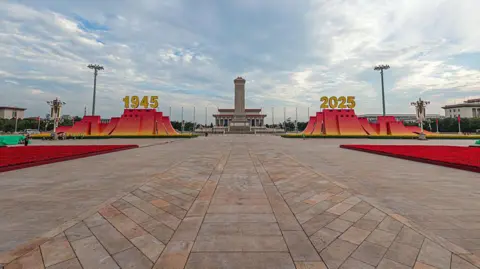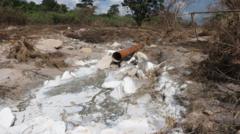**Article Text:**
In the heart of Zambia's Copperbelt, renowned visual artist Stary Mwaba emerges as a voice for the voiceless, capturing the harrowing realities of "black mountains"—massive piles of toxic mining waste that loom ominously over the skyline. Growing up nearby, Mwaba has personal ties to these mountains, recalling playful childhood moments amidst their perilous surroundings. “We called it 'mu danger' – ‘in danger’,” he shares, reflecting on the place where wild fruits surprisingly thrived.
Today, these black mountains attract a different crowd: young men desperately searching for copper ore buried within the waste. Despite the dangers and illegality of their work, this has become a means of survival for many, especially in a region grappling with 45% youth unemployment.
Mwaba's latest exhibition at the Lusaka National Museum narrates the lives of miners in Kitwe, illuminating the human stories intertwined with this toxic backdrop. Young miners, often working under "jerabos," or gang masters, face not just physical risks but also economic exploitation. Through large portraits created on newspapers, Mwaba juxtaposes "grand narratives" of societal issues with "little narratives"—the individual stories of resilience that deserve visibility, despite their fragility.
His artwork reflects both the struggles and joys of life within the shadow of the black mountains. One poignant piece, titled “Jerabo,” depicts a miner preparing to descend into hazardous tunnels, embodying the dangers that penetrate their existence. Mwaba’s creative methods involve burning the newspaper articles to craft holes and layering paint over them, a metaphor for how personal narratives are often overshadowed by larger social issues.
In workshops held in Wusakile, Mwaba engages with local youth to hear their stories of hardship and survival, further fueling his artistic exploration. His pieces, including “Shofolo,” showcase the essential tools of mining, while others, like “Ipenga,” celebrate community through music and spirituality.
Mwaba's work is not just an exploration of art but also a response to socio-economic struggles exacerbated by mining practices. His emotional connection to the area is deep-rooted, stemming from a lineage of miners who faced the harsh realities of the industry. The significant upheaval following Zambia’s 1994 privatization of mines left a profound impact on communities, leading to rampant poverty and a dependence on the hazardous black mountains.
However, the pitfalls of this lifestyle also extend beyond individual hardship. Mwaba recalls the frustration from his workshops where young miners feel trapped in a cycle of exploitation, manipulated by those living off the wealth generated from their labor. His piece "Boss for a Day" reflects their hopes for empowerment amidst a system designed to keep them in precarious circumstances.
Stary Mwaba stands at the intersection of art and activism, using his medium to shine a spotlight on the overlooked narratives surrounding Zambia's mining industry. His works serve not only as artistic expressions but also as a clarion call for change, urging society to recognize and support the resilience of the young miners and their communities. Through his profound storytelling, Mwaba illuminates the pressing need to confront the socio-environmental issues surrounding the legacy of mining in Zambia.
In the heart of Zambia's Copperbelt, renowned visual artist Stary Mwaba emerges as a voice for the voiceless, capturing the harrowing realities of "black mountains"—massive piles of toxic mining waste that loom ominously over the skyline. Growing up nearby, Mwaba has personal ties to these mountains, recalling playful childhood moments amidst their perilous surroundings. “We called it 'mu danger' – ‘in danger’,” he shares, reflecting on the place where wild fruits surprisingly thrived.
Today, these black mountains attract a different crowd: young men desperately searching for copper ore buried within the waste. Despite the dangers and illegality of their work, this has become a means of survival for many, especially in a region grappling with 45% youth unemployment.
Mwaba's latest exhibition at the Lusaka National Museum narrates the lives of miners in Kitwe, illuminating the human stories intertwined with this toxic backdrop. Young miners, often working under "jerabos," or gang masters, face not just physical risks but also economic exploitation. Through large portraits created on newspapers, Mwaba juxtaposes "grand narratives" of societal issues with "little narratives"—the individual stories of resilience that deserve visibility, despite their fragility.
His artwork reflects both the struggles and joys of life within the shadow of the black mountains. One poignant piece, titled “Jerabo,” depicts a miner preparing to descend into hazardous tunnels, embodying the dangers that penetrate their existence. Mwaba’s creative methods involve burning the newspaper articles to craft holes and layering paint over them, a metaphor for how personal narratives are often overshadowed by larger social issues.
In workshops held in Wusakile, Mwaba engages with local youth to hear their stories of hardship and survival, further fueling his artistic exploration. His pieces, including “Shofolo,” showcase the essential tools of mining, while others, like “Ipenga,” celebrate community through music and spirituality.
Mwaba's work is not just an exploration of art but also a response to socio-economic struggles exacerbated by mining practices. His emotional connection to the area is deep-rooted, stemming from a lineage of miners who faced the harsh realities of the industry. The significant upheaval following Zambia’s 1994 privatization of mines left a profound impact on communities, leading to rampant poverty and a dependence on the hazardous black mountains.
However, the pitfalls of this lifestyle also extend beyond individual hardship. Mwaba recalls the frustration from his workshops where young miners feel trapped in a cycle of exploitation, manipulated by those living off the wealth generated from their labor. His piece "Boss for a Day" reflects their hopes for empowerment amidst a system designed to keep them in precarious circumstances.
Stary Mwaba stands at the intersection of art and activism, using his medium to shine a spotlight on the overlooked narratives surrounding Zambia's mining industry. His works serve not only as artistic expressions but also as a clarion call for change, urging society to recognize and support the resilience of the young miners and their communities. Through his profound storytelling, Mwaba illuminates the pressing need to confront the socio-environmental issues surrounding the legacy of mining in Zambia.




















